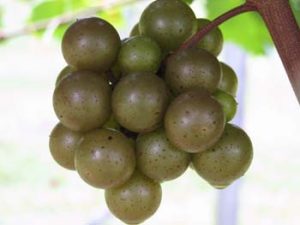
Lovers of the grape are scheduled to gather Saturday for the sixth annual N.C. Muscadine Harvest Festival in Kenansville. In honor of the occasionally-maligned vitis rotundifolia, we present herewith a few facts about Muscadines.
–There are numerous varieties of Muscadine grapes. The terms Muscadine and Scuppernong are often used interchangeably. In fact, Scuppernong is one variety of Muscadine. “All Scuppernongs are Muscadines. But not all Muscadines are Scuppernongs.”
–Muscadine varieties range from bronze to dark purple to black in color. They are characterized by a thick, often bitter skin and a juicy, gelatinous pulp. Varietal names include Magnolia, Fry, Triumph, Nesbitt, Black Fry and Ison.
–Writing in the early 1700s, naturalist John Lawson described six sorts of wild grapes growing in North Carolina. According to Lawson, they differed in their color and the season in which they were ripe.
–The Scuppernong, also once known as the White Grape, the Big White Grape and the Roanoke, earned its name from the Scuppernong River, Scuppernong Lake (now Lake Phelps) and the settlement of Scuppernong. Not the other way around.
–The word Scuppernong is believed to be derived from the Algonquian word askuponong, which means at the place of the askupo, sweet bay or Magnolia virginiana (a small evergreen common in the states lowlands).
–In 1840 North Carolina was the premier winemaking state in the U.S.
–At the turn of the 20th century Halifax County native Paul Garrett took top honors at wine competitions in Paris and St. Louis for his scuppernong wines. Garrett’s Virginia Dare wine was one of the most popular wines in the U.S. in the first half of the 20th century.
–Muscadines are reported to have an antioxidant level 40 times higher than any other grape. The main antioxidants found in Muscadines can play a key role in preventing cancer, heart disease, high cholesterol and in treating such ailments as arthritis, topical burns and the flu.
–The Scuppernong was named North Carolina’s state fruit in 2001.
Want to know more? Try these sources:
Clarence Gohdes’s Scuppernong: North Carolina’s Grape and Its Wine
The North Carolina Muscadine: A Historical Timeline
The North Carolina Muscadine Grape Association
The North Carolina Department of Agriculture’s Muscadine Media Kit.

